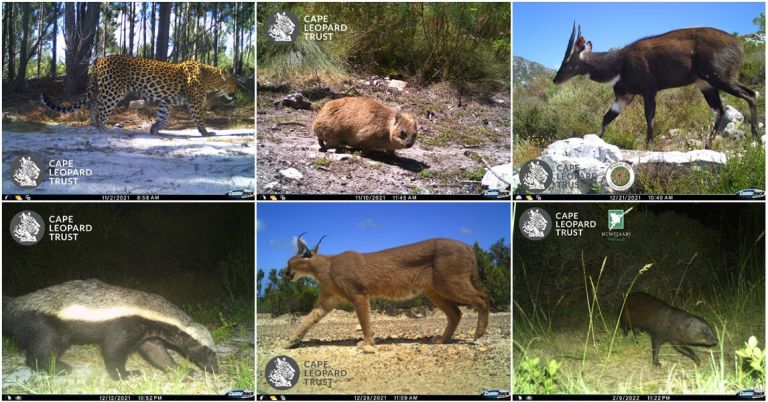The Cape Leopard Trust Research team is thrilled to report that our large-scale survey of the Overberg was successfully completed in early 2022, with many happy surprises and amazing captures obtained from the camera grid! (Find earlier updates on the survey here and here)
The survey, which spanned an area of over 2400 km2 from Botvlei in the west to De Hoop vlei in the east, ran from mid-August 2021 to the end of January 2022. Eighty-six paired camera stations were placed along jeep tracks and hiking trails in this region of heavily fragmented Fynbos habitat. Land-use types ranged from private nature reserves and national parks, to agriculture (including livestock, vineyards, orchards and grains) and game keeping, as well tourism and leisure activities (hiking and mountain bike trails).
By the end of the survey, we had amassed just over 230 000 photos. Manually sorting, identifying and tagging all of these is a mammoth task and we are very fortunate to have amazing support from WildID – a fantastic online machine learning programme that semi-automates the process of identifying and labelling the species in each of these images! See the CLT case study here.
Initial results from the survey indicate good species diversity with at least 27 native wild mammal species recorded, as well as a number of re-introduced and non-native species. The cameras spotted several animals that the CLT team is not used to seeing such as hippo (in the Nuwejaars Wetlands SMA), a Cape dune molerat, fallow deer and a lone vervet monkey (possibly an escaped pet).
Although birds regularly show up on our camera traps in regions like the Cederberg, Boland, Piketberg and Little Karoo, we were quite surprised by the number and variety of different birds recorded in the Overberg – with at least 15 different feathered species making an appearance on the cameras. Even more heartening was the presence of many baby birds – with blue cranes, Denham’s bustard, ostriches and spur-winged geese all showing off their chicks.
Encouragingly, the survey also recorded widespread leopard presence (at 50 of the 86 camera trap stations – representing 58% of locations). Using pattern recognition software and observer confirmation by eye, at least 24 adult leopards and 7 juveniles (from 4 litters) have been individually identified from the 526 leopard photographs taken. Together with an MSc student from the University of Cape Town, we are now working to ascertain the leopard population density in the greater Overberg region.
A camera survey of this magnitude can really only be successful with the buy in and support of all parties involved, and the Cape Leopard Trust team would like to thank all the landowners who assisted us and permitted us to place camera traps on their properties. We extend our heartfelt appreciation to Walker Bay Fynbos Conservancy and Nuwejaars Wetlands SMA for their invaluable assistance with fieldwork and landowner communication, with special thanks to Denel OTR, SANParks Agulhas NP and CapeNature for their collaboration.
Cameras for Conservation
Have you ever wondered how we go about setting up a large-scale camera survey, and how we use the data to inform conservation? Then have a look at our “Cameras 4 Conservation” video series – specially created to share the research process with our supporters. Watch Part 1 on YouTube, and keep an eye on our channels for the release of Parts 2 and 3 later this year!
Please enjoy this showreel of highlight camera trap photos from the Overberg below!

















